Sony just packed a 1” stacked CMOS sensor into the Xperia Pro-I, but there’s a catch
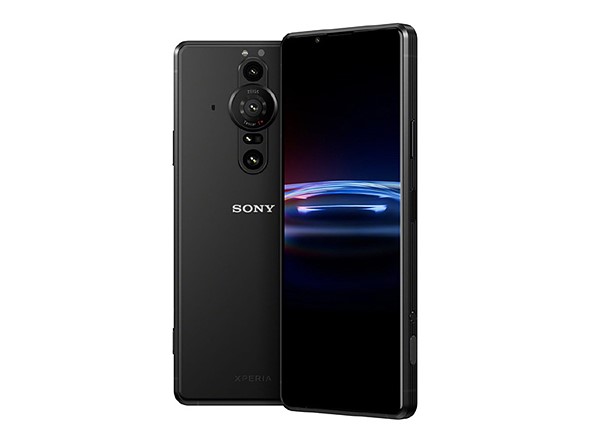 |
Sony has unveiled the Xperia Pro-I, its latest flagship smartphone with a triple camera array and a particularly headline-grabbing feature: for its main camera, it uses the same 20MP 1″-type stacked CMOS sensor with built-in memory and phase-detection autofocus as the one inside Sony’s RX100 VII compact camera. But there’s a catch: only a central section of that 20MP sensor is used to output a 12MP still (or 4K video), and that has some broad implications we’ll delve into below.
It’s not the first time we’ve seen a 1″-type sensor in a smartphone: Panasonic did it with the oversized CM1. More recently, Sharp managed to cram a 1″-type sensor and a 19mm equivalent, F1.9 lens into a relatively small form factor in its Aquos R6. Samples indicate quite good image quality, as you might expect from this size sensor, but the lack of computational imaging techniques—at least comparatively—meant it didn’t always stack up so well next to competitors with less impressive hardware.
Sony’s Xperia Pro-I managed to keep its form factor similar to Sony’s previous Xperia devices. So what did it sacrifice, and what improvements does it bring to the line? Let’s take a look.
Key specifications:
- 20MP 1″-type stacked-CMOS Exmor RS sensor with built-in DRAM (2.4µm pixels)
*only 12MP, or ~60%, central portion used for 4:3 stills - 315 PDAF points with 90% coverage on main, wide 24mm equiv. camera
- 16mm equiv. F2.2 ultra-wide camera with 1/2.5″ Dual-PD Exmor RS for mobile sensor (1.4µm pixels)
- 50mm equiv. F2.4 telephoto camera with 1/2.9″ Dual-PD Exmor RS for mobile sensor (1.2 µm pixels)
- 4K/120p native recording with Real-time tracking and Eye AF
- 3D iToF sensor aids autofocus for all rear cameras (ultra-wide, wide, telephoto)
- Real-time tracking available for all rear cameras (ultra-wide, wide, telephoto)
- Dedicated Bionz X processor with front-end LSI for dedicated image processing
- Anti-distortion shutter, 12-bit Raw output
The big story is of course the 1″-type stacked CMOS sensor from the RX100 VII. However, in order to keep the phone small, Sony has designed a lens that can’t project an image circle large enough to cover the entire area of the 1″ sensor. That’s why, instead of 20MP images, as you’d get from the RX100 VII camera, you get 12MP images. But this has a broader implication: the combination of a slower F2 lens (than many of its peers) and a sensor that’s not quite as big as a 1″-type sensor means the image quality is not going to be what you might expect from an RX100. In fact, if you consider just the area used for 12MP stills, it has roughly a 12mm diagonal and 70mm2 sensor surface area: closer to the specs of a 1/1.31″ sensor.
With an F2 lens, we calculate that the main camera is then roughly F7.1 full-frame equivalent. Compared to the iPhone 13 Pro’s 1/1.65″ sensor with F1.5 lens, which makes it F6.8 full-frame equivalent, that means the main imager on the Xperia Pro-I actually offers slightly less light gathering ability and slightly more depth-of-field than the iPhone 13 Pro, and that’s before you consider computational imaging approaches.
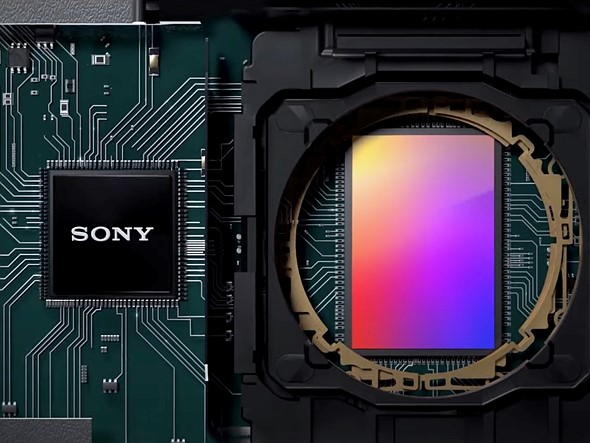 |
In front of the sensor is a newly designed 24mm (full-frame equivalent) Zeiss Tessar lens with T* anti-reflective coatings and an aspherical lens element to deliver less peripheral distortion, better contrast and sharpness. This design, along with the decision to project an image circle that covers only roughly 60% the diagonal of the full 1″-type sensor allowed the lens to remain relatively slim, meaning the Pro-I is barely thicker than its siblings. There’s also a clever dual-aperture (F2 and F4) mechanism in this main lens that mechanically drops one of two aperture plates to change the depth-of-field, and light-gathering ability.
The ultrawide camera inside the Xperia Pro-I is a 12MP 16mm (equiv.) F2.2 camera module with Dual-PD (or dual pixel) autofocus—the same seen in Sony’s Xperia 1/5 Mark III smartphones. Sony has also reused the 12MP 1/2.9” sensor in its prior telephoto camera modules, but notes the new 50mm equiv. F2.4 lens inside the Xperia Pro-I has been redesigned and features optical image stabilization (OIS).
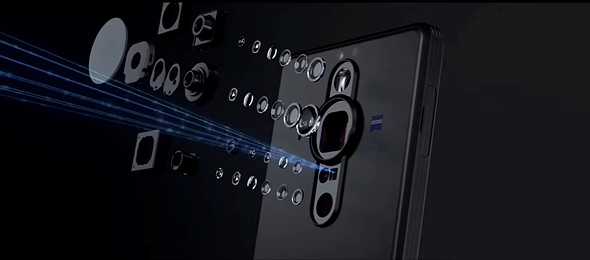 |
All three of the rear camera modules use Exmor RS-branded sensors, but Sony says the 24mm (equiv) module, is referred to as ‘Exmor RS,’ while the 16mm and 50mm (equiv) modules are being referred to as ‘Exmor RS for mobile.’ All three sensors are memory stacked, though, which allows for faster sensor readout as information can be temporarily stored in DRAM before the downstream processors are freed up. This in turn frees up the sensor to continue operating, take its next exposure, etc. All three sensors use the onboard 3D iToF sensor to speed up autofocus performance by calculating the distance between the camera and subject.
All three cameras have AI Super Resolution zoom modes. Sony has also included Real-time Eye AF for humans and animals, as well as real-time tracking (AF/AE) at up to 20 fps bursts.
All three of the rear camera modules capture 12-bit Raw images, and offer anti-distortion (electronic) shutters thanks to the fast sensor readouts. We estimate the main camera sensor to have a readout rate below 8.3ms, which means it’s fast enough for anything but the most extreme motion. The ultra-wide and telephoto modules will also have fast readout rates, but likely a bit slower than that of the advanced 1″-type sensor in the main camera. All three cameras have AI Super Resolution zoom modes. Sony has also included Real-time Eye AF for humans and animals, as well as real-time tracking (AF/AE) at up to 20 frames per second (fps) bursts. AF/AE calculations are performed at 60 times per second.
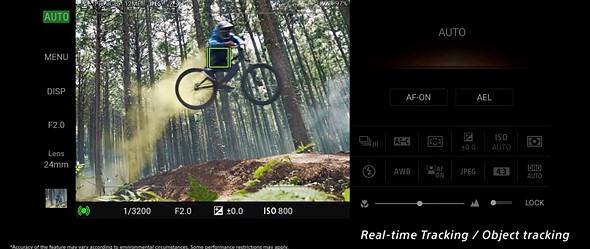 |
To process all of the data coming off the sensors, Sony has included a Bionz X processor with front-end LSI, marking the first time Sony has used a dedicated image processing chip inside an Xperia device. The Bionz X is used for both object recognition, as well as tracking and image signal processing. Sony says it can process the Raw data at up to 24fps. And like the Xperia 1 Mark III, when shooting 10 or 20 fps bursts in low conditions, the camera can align and merge up to 4 frames to decrease noise for each frame in the burst, something no camera to date we know of can do in high speed burst mode. The autofocus system, which is also powered by the Bionz X processor, uses 315 AF points to cover 90% of the frame, up from 70% on the Xperia 1 III.
Video
The Xperia Pro-I is the first smartphone to offer native 4K/120p capture, which can be watched back natively at 4K, 120Hz thanks to the capabilities of the display, for a hyper-realistic video experience (previous Xperia models could capture in 4K/120p, but only record the video at a lower frame rate, as slow-motion video).
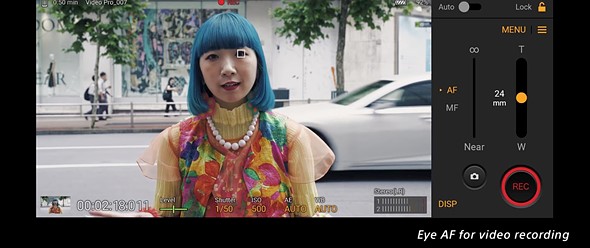 |
| This is the first time Eye AF has been included in video shooting on a smartphone. |
This is the first Xperia device to offer Eye AF and ‘Real-time’ object tracking in video, both of which work just as they do in Sony’s recent Alpha cameras. The 24mm and 50mm (equiv.) camera modules offer Optical SteadyShot image stabilization and all three camera modules can use Sony’s FlawlessEye electronic image stabilization, which utilizes the fast sensor scan rates of the stacked sensors to improve electronic image stabilization. The faster an electronic exposure can be read, the longer the time before the next exposure; this additional processing time leads to improved image stabilization.
There are two stereo microphones onboard the Xperia Pro-I as well as a monaural microphone next to the main camera. Sony says this microphone is designed ‘to focus on recording speech clearly while other sounds remain in the background.’
User interface
The user interface (UI) of the first-party camera app is designed specifically to replicate the interface used in Sony’s mirrorless camera lineup for a more seamless transition between the two formats. Sony has even added the same shutter switch module from the RX100 series cameras on the side of the Xperia Pro-I to keep the ergonomics similar as well.
For both stills and video capture, Sony has split the camera interface into two ‘Creative Control’ interfaces that offer different settings and menus depending on what you’re shooting (for a total of four). When shooting stills, you get ‘Basic’ mode and ‘Photography Pro’ mode. In Basic mode, the interface is similar to most other mobile camera apps, with a touch shutter button on the screen and all of your basic settings to quickly capture images on the go. ‘Photography Pro’ mode, which can be summoned by long-pressing on the RX-style shutter button on the side of the device, offers a more comprehensive interface with manual settings and the 12-bit Raw capture mode.
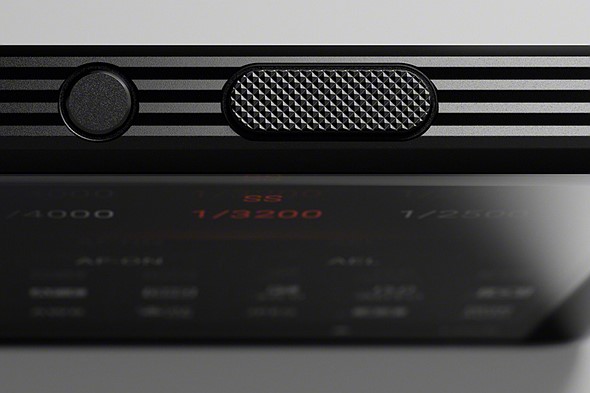 |
When shooting video, Sony has ‘Video Pro,’ and ‘Cinema Pro.’ The ‘Video Pro’ interface is designed ‘for immediate sharing’ with an emphasis on vlogging, mobile journalism and other use-cases that require quick turn-around. All of your basic settings are in easy-to-access places for quick compositions and captures. ‘Cinema Pro,’ on the other hand, is designed for cinematographers and pulls inspiration from Sony’s professional video camera technology by adding ‘eight different color settings inspired by Sony’s VENICE digital cinema camera, a 21:9 recording ratio and more.’ There’s also a dedicated pull focus option for smoothly transitioning focus from one subject to another by tapping the subject on the screen.
Display
Like the Xperia 1 Mark III, the Xperia Pro-I uses a 6.5″ 4K HDR 10-bit (8-bit with 2-bit temporal dithering, or FRC) OLED display with a 21:9 aspect ratio and a 120Hz refresh rate. Like the displays on all recent high-end Xperias, the color gamut extends a bit beyond DCI-P3, and the panel can achieve a peak brightness of 1000 and 400 nits for 1% and 100% APL (average picture level), respectively, for HDR content. It tends to be dimmer in standard use and for SDR content, which has been problematic in the past, particularly when using the camera outdoors – a problem Sony claims it has tried to address. It’s driven by the same X1 processor found in Sony’s Bravia televisions, which Sony claims makes ‘for more contrast, color, and clarity,’ and is covered by Corning Gorilla Glass Victus.
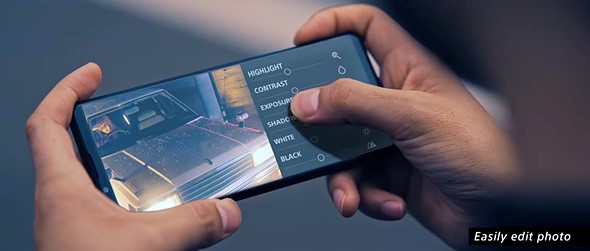 |
As was possible with previous Xperia devices, the Xperia Pro-I can be used as an external OLED video monitor. If you’re using a compatible Sony ZV-series camera, you can connect directly over USB-C, while other camera systems can be used by converting the HDMI output to USB-C via a compatible dongle (Sony doesn’t specify what particular dongles have been proven to work without issue). A ‘Creator Mode‘ ensures color accuracy, switching the display between Rec. 709 and Rec. 2020 gamuts as needed based on content, and each panel is individually calibrated at the factory for accurate white point. While these features are useful particularly for content creators, they’ll be appreciated by discerning content consumers as well.
Connectivity
At the heart of the Xperia Pro I is a Qualcomm Snapdragon 888 5G chipset with 12GB of RAM and 512GB of solid-state storage onboard. Other features include an IP65/68 rating, a 4,500mAh battery that can charge up to 50% in 30 minutes with a 30W charger and a dedicated gaming mode.
On the connectivity front, the Xperia Pro-I offers 5G (Sub 6) and Wi-Fi 6. Physical I/O includes a single USB-C port, a 3.5mm audio jack and—get ready—a micro SD card slot with support for up to 1TB micro SD cards.
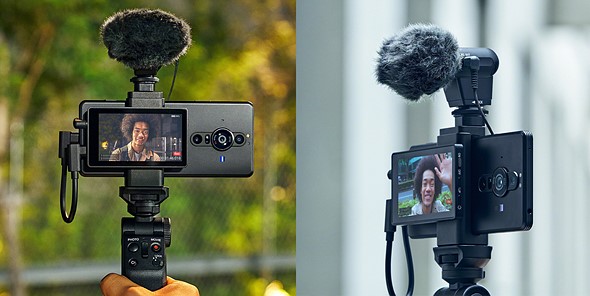 |
For users who intend to use the Xperia Pro-I as a vlogging rig, and want to take advantage of the bigger image sensor and larger exit pupil of the new 24mm equiv. lens on the main rear camera, Sony has developed a 3.5″ Vlog Monitor that magnetically attaches to the rear of the smartphone mount. It connects to the Xperia Pro-I via USB-C so you can compose and record with the back of the camera facing you. There’s also a 3.5mm headphone jack so you can record audio via an external microphone right to the Vlog Monitor. The rig becomes even more compelling when pairing it with Sonys GP-VPT2BT Bluetooth shooting grip, as you can start and stop recording without needing to turn the rig around to tap on the screen. Sony notes third-party Bluetooth grips should work as well.
Availability
As part of its ‘Road to Zero’ environmental plan, which aims to get the company to a net-zero environmental impact by 2050, the Xperia Pro-I uses no plastic in the individual packaging, instead using only paper as the packaging material.
The Sony Xperia Pro-I will be available unlocked for $1,800. Pre-orders start at 10am EDT on October 28, 2021 through authorized Sony retailers and the first units are expected to ship out December 10, 2021. The Vlog Monitor is expected to ship at the same time for $200. If you pre-order the two together, you can save $50 on the total price and if you toss in Sony’s GP-VPT2BT grip as well, you’ll get $100 off your total order price.
You can find out more details on the Sony Xperia Pro-I and Vlog Monitor on Sony’s website.




 Started out doing photography at the age of 6 using an uncle's old 1940 kodak brownie box camera. At 15 years of age, I decided to buy my very own 1975 Praktica SLR camera. I now shoot with a Nikon D850. I do unpaid TFP and commercial paid work.
Started out doing photography at the age of 6 using an uncle's old 1940 kodak brownie box camera. At 15 years of age, I decided to buy my very own 1975 Praktica SLR camera. I now shoot with a Nikon D850. I do unpaid TFP and commercial paid work.